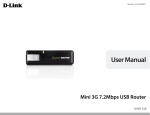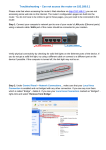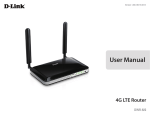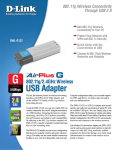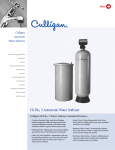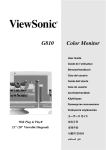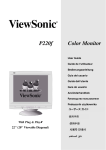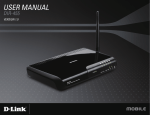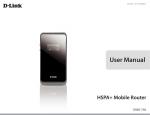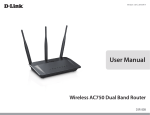Download User Manual - D-Link
Transcript
Version 1.0 | August 6, 2012 User Manual Mini 3G 21Mbps USB Router DWR-710 Preface D-Link reserves the right to revise this publication and to make changes in the content hereof without obligation to notify any person or organization of such revisions or changes. Manual Revisions Revision Date 1.0 August 6, 2012 Description • Initial release Trademarks D-Link and the D-Link logo are trademarks or registered trademarks of D-Link Corporation or its subsidiaries in the United States or other countries. All other company or product names mentioned herein are trademarks or registered trademarks of their respective companies. Copyright © 2012 by D-Link Corporation. All rights reserved. This publication may not be reproduced, in whole or in part, without prior expressed written permission from D-Link Corporation. D-Link DWR-710 User Manual i Table of Contents Table of Contents Preface.................................................................................. i Manual Revisions............................................................................ i Trademarks....................................................................................... i Product Overview............................................................... 1 Package Contents.......................................................................... 1 System Requirements.................................................................. 1 Introduction.................................................................................... 2 Hardware Overview...................................................................... 3 Front........................................................................................... 3 Back............................................................................................ 4 Wireless Installation Considerations....................................... 5 Product Setup................................................................................. 6 Web-Based Configuration Utility...................................... 7 Internet Connection Setup Wizard.......................................... 8 Internet Setup...............................................................................11 Wireless Settings..........................................................................12 Manual Wireless Setup..............................................................15 Network Setup..............................................................................16 SIM Settings...................................................................................17 MAC Filter.......................................................................................18 Advanced Internet Settings.....................................................19 Advanced Wireless......................................................................20 Administrator Settings..............................................................21 SMS Messages..............................................................................22 Factory Reset.................................................................................23 D-Link DWR-710 User Manual Firmware Upgrade......................................................................24 Device Information.....................................................................25 Statistics..........................................................................................26 Wireless Information..................................................................27 Support...........................................................................................28 Wireless Security..............................................................29 What is WEP?.................................................................................29 Configure WEP..............................................................................30 What is WPA?.................................................................................31 Configure WPA-PSK/WPA2-PSK..............................................32 Connect to a Wireless Network........................................33 Using Windows 7.........................................................................33 Connect to a Wireless Network........................................36 Using Windows Vista..................................................................36 Configure Wireless Security.............................................37 Using Windows XP......................................................................39 Configure WEP......................................................................40 Configure WPA-PSK.............................................................42 Troubleshooting...............................................................44 Wireless Basics..................................................................46 What is Wireless?..........................................................................47 Wireless Modes.............................................................................50 ii Table of Contents Networking Basics............................................................51 Check your IP address................................................................51 Statically Assign an IP address................................................52 Warnings and Declarations..............................................53 Technical Specifications...................................................57 D-Link DWR-710 User Manual iii Section 1 - Product Overview Product PackageOverview Contents DWR-710 Mini 3G 21Mbps USB Router Quick Install Guide Companion Card If any of the above items are missing from your package, please contact your reseller. System Requirements • A compatible (U)SIM card with service1 • Computers with Windows®, Macintosh® , or Linux-based operating systems • Internet Explorer 6 or higher, Firefox 2.0 or higher, or another Java-enabled browser (for configuration) 1 D-Link DWR-710 User Manual Subject to services and service terms available from your carrier. 1 Section 1 - Product Overview Introduction The D-Link DWR-710 Mini 3G 21Mbps USB Router is a palm sized 3G router, slim and small enough to carry in your pocket. It allows you to access and share your 3G mobile Internet connection anywhere and anytime. The DWR-710 functions as a Wi-Fi router allowing Wi-Fi capable devices like smart phones, portable gaming devices, notebooks, or digital cameras access to 3G networks via a wireless connection. The DWR-710 can share its 3G connection with up to six Wi-Fi clients, providing an instant connection to the Internet. D-Link DWR-710 User Manual 2 Section 1 - Product Overview Hardware Overview Front Status LED Wi-Fi LED USB Connector/Removable Cover Indicator Color Solid Blinking Status LED Purple Blue Green Red Amber Green HSPA+ Network connection WCDMA/HSDPA/HSUPA network GSM/GPRS network SIM error or No service Roaming operator found, but service not active WiFi active Transmitting Transmitting Transmitting WiFi LED D-Link DWR-710 User Manual Transmitting Transmitting 3 Section 1 - Product Overview Hardware Overview Back Removable Cover USB Connector Port/LED USB Connector D-Link DWR-710 User Manual Function Connects to a PC through a USB port. 4 Section 2 - Installation Wireless Installation Considerations The DWR-710 can be accessed using a wireless connection from virtually anywhere within the operating range of your wireless network. Keep in mind, however, that the quantity, thickness and location of walls, ceilings, or other objects that the wireless signals must pass through, may limit the range. Ranges vary depending on the types of materials and background RF (radio frequency) noise in your home or office. The key to maximizing the wireless range is to follow these basic guidelines: 1. Minimize the number of walls and ceilings between the D-Link router and other network devices. Each wall or ceiling can reduce your adapter’s range from 3 to 90 feet (1 to 30 meters). 2. Be aware of the direct line between network devices. A wall that is 1.5 feet thick (0.5 meters), at a 45-degree angle appears to be almost 3 feet (1 meter) thick. At a 2-degree angle it appears over 42 feet (14 meters) thick. Position devices so that the signal can travel straight through a wall or ceiling (instead of at an angle) for better reception. 3. Try to position access points, wireless routers, and computers so that the signal passes through open doorways and drywall. Materials such as glass, metal, brick, insulation, concrete, and water can affect wireless performance. Large objects such as fish tanks, mirrors, file cabinets, metal doors, and aluminum studs may also have a negative effect on range. 4. If you are using 2.4 GHz cordless phones, make sure that the 2.4 GHz phone base is as far away from your wireless device as possible. The base transmits a signal even if the phone in not in use. In some cases, cordless phones, X-10 wireless devices, and electronic equipment such as ceiling fans, fluorescent lights, and home security systems may dramatically degrade wireless connectivity. D-Link DWR-710 User Manual 5 Section 2 - Installation Product Setup 1. Remove the back cover of the DWR-710 and insert the SIM card with the gold contacts facing down. Make sure that you insert the SIM card in the right direction. 2. Remove the DWR-710 USB Connector cover and insert the router into a USB port on your computer. 3. The Driver Installation program will open automatically. Follow the prompts until driver installation completes. 4. When Driver Installation is completed, a D-Link HSPA+ Router shortcut will placed on your on desktop. Double-click the shortcut to automatically launch your web browser and begin using the web-based configuration utility. D-Link DWR-710 User Manual 6 Section 3 - Configuration Web-Based Configuration Utility You can use the web-based configuration utility to manage your wireless network. It allows you to set up your wireless network details and enable wireless encryption. Note: The web-based configuration utility and its associated features are for both Modem and Router modes. To access the configuration utility, double-click the D-Link HSPA+ Router shortcut or open a web browser such as Internet Explorer or Firefox, and then enter the IP address of the router (192.168.0.1 by default). or Type admin in the User Name field and then enter your password. Leave the password blank by default. Click the Login button to log in to the router. If you get a Page Cannot be Displayed error, please refer to the Troubleshooting section for assistance. D-Link DWR-710 User Manual 7 Section 3 - Configuration Internet Connection Setup Wizard Once logged into the web interface of the router, the Setup > Internet page will appear. Click the Internet Connection Setup Wizard button to quickly configure your router using the setup wizard. If you want to enter your settings without running the wizard, click Manual Internet Connection Setup and skip to “Manual Internet Configuration”. D-Link DWR-710 User Manual 8 Section 3 - Configuration Click Next to continue. Create a new password and then click Next to continue. Configure your 3G Internet Connection settings and then click Next to continue. D-Link DWR-710 User Manual 9 Section 3 - Configuration Click Connect to save your settings. Once the router has finished rebooting, click Continue. Please allow 1-2 minutes to connect. D-Link DWR-710 User Manual 10 Section 3 - Configuration Internet Setup This section lets you manually enter the Internet connection information provided by your Internet Service Provider (ISP). Auto APN: If you want to enable Auto APN, tick the check box. ISP: Enter the name of your ISP. Username: Enter the username for your mobile Internet connection. Password: Enter the password for your mobile Internet connection. APN: Enter the APN description. Reconnect Mode: Set to Always On, On Demand, or Manual. Note: Always On and On Demand will allow the device to connect/reconnect to their Internet service automatically. You may incur usage fees based on your Internet service provider plan. Maximum Idle Time: Enter a maximum idle time in minutes before disconnecting from your mobile Internet service. Choose 0 to disable automatic disconnection. D-Link DWR-710 User Manual 11 Section 3 - Configuration Wireless Settings If you want to configure the wireless settings on your router using the wizard, click Wireless Connection Setup Wizard. If you want to manually configure the wireless settings on your router click Manual Wireless Connection Setup and refer to “Manual Wireless Connection Setup”. Click the Wireless Connection Setup Wizard button to view the Wireless Security Setup Wizard menu. The Welcome menu lists the steps used for setup. Click on the Next button to continue. D-Link DWR-710 User Manual 12 Section 3 - Configuration Enter the SSID (Service Set Identifier). The SSID is the name of your wireless network. Create a name using up to 20 characters. The SSID is case-sensitive. It is recommended that you tick the checkbox to use WPA wireless encryption to secure your wireless network. Click Next to continue. Type a password that you would like to use for your wireless network in the Network Key: entry field. Click Next to continue. D-Link DWR-710 User Manual 13 Section 3 - Configuration The final menu appears to indicate that setup is complete. You should write down the Wireless Network Name (SSID) and Network Key for future reference when connecting other wireless devices to your wireless network. Click Save to finish the Security Wizard. D-Link DWR-710 User Manual 14 Section 3 - Configuration Manual Wireless Setup Use this section to configure the wireless settings for your D-Link router. Wireless Network Check box to enable (Router mode); Settings : Uncheck to disable (Modem mode) Wireless Network Name: Enter a wireless network name. Wireless Channel: Choose the wireless channel. Security Mode: Choose the wireless security mode. D-Link DWR-710 User Manual 15 Section 3 - Configuration Network Setup Use this section to configure the internal network settings of your router. Router IP Address: Enter the router IP address. Subnet Mask: Enter the subnet mask. Enable DHCP Server: If you want to enable DHCP Server, check Enabled. Otherwise, check Disabled. It is recommended that you leave this setting Enabled. DHCP IP Address Range: Enter values for the DHCP IP address range. D-Link DWR-710 User Manual 16 Section 3 - Configuration SIM Settings This is where you set protections for gaining access to your SIM card. Enable/ Disable PIN If you would like to enable or disable the PIN Function: authentication function, click Enable/Disable PIN Function. Modify PIN Code: If you want to modify the current or default PIN value, click Modify PIN Code to change it. D-Link DWR-710 User Manual 17 Section 3 - Configuration MAC Filter Use MAC (Media Access Control) Filters to control access to your network based on the MAC addresses of connected clients. You can set MAC address filtering to only allow specific computers or devices to connect, or block access to all listed MAC addresses. Select Enabled to enable MAC filtering, and then enter the MAC addresses of the computers and devices you want to have access. Select Disabled if you do not wish to filter MAC addresses. D-Link DWR-710 User Manual 18 Section 3 - Configuration Advanced Internet Settings Use this section to set the search methods, data roaming preferences and type of mobile Internet network connection the router will use. Network Search Method: Determine whether the router will search for available carriers automatically, or to only connect to the carrier you specify. Data Roaming: Enabling Data Roaming will allow the router to use your data connection when on an outside carrier’s network. Disabling it will prevent the router from doing this, but will still allow you to send and recieve SMS messages. Network Type: Allows you to determine whether the router will connect via 2G only, 3G only, or 2G and 3G(whichever is available) D-Link DWR-710 User Manual 19 Section 3 - Configuration Advanced Wireless Use this section to specify advanced wireless options. Broadcast SSID: Enable to allow any wireless client to find your wireless network. Disable to require all wireless clients to manually enter your wireless network’s SSID and settings to connect. TxPower: Set the transmit power and strength of your wireless network. A higher setting will boost coverage area, but uses more battery power. Max. Associated Number: Determines the maximum number of wireless PCs, devices, and other clients that can connect to your wireless network. D-Link DWR-710 User Manual 20 Section 3 - Configuration Administrator Settings Use this section to change the password for the Administrator account. Password: Enter a password. Verify Password: Verify the password. D-Link DWR-710 User Manual 21 Section 3 - Configuration SMS Messages The DWR-710 allows you to read, write, and send SMS messages directly from the user interface. Note: You must insert a SIM card to use this feature. D-Link DWR-710 User Manual 22 Section 3 - Configuration Factory Reset Use this section to restore the router to the factory default settings. Restore To Factory Click this button to restore all settings to the Default: factory defaults. D-Link DWR-710 User Manual 23 Section 3 - Configuration Firmware Upgrade After downloading a firmware file to your computer, click Choose File to select the firmware file, then click Upgrade to start the upgrade process. Note: Do not turn off or disconnect the power during the upgrade process, or you may cause damage to your device. D-Link DWR-710 User Manual 24 Section 3 - Configuration Device Information All of your Internet and network connection details are displayed on this page. The firmware version is also displayed here. General: Displays the firmware version. WAN: Displays information about the WAN. LAN: Displays information about the LAN. D-Link DWR-710 User Manual 25 Section 3 - Configuration Statistics All of your Internet traffic details are displayed on this page. Clear History: Clears the traffic statistics information D-Link DWR-710 User Manual 26 Section 3 - Configuration Wireless Information All of your wireless connection details are displayed on this page. Number of wireless Displays the wireless clients and their clients: MAC addresses. D-Link DWR-710 User Manual 27 Section 3 - Configuration Support This screen gives you more information about the various parts of the configuration interface. Click on a link to learn more about that topic. D-Link DWR-710 User Manual 28 Section 4 - Security Wireless Security This section will show you the different levels of security you can use to protect your data from intruders. The DWR-710 offers the following types of security: • WPA2 (Wi-Fi Protected Access 2) • WPA2-PSK (Pre-Shared Key) • WPA (Wi-Fi Protected Access) • WPA-PSK (Pre-Shared Key) • WEP (Wired Equivalent Privacy) What is WEP? WEP stands for Wired Equivalent Privacy. It is based on the IEEE 802.11 standard and uses the RC4 encryption algorithm. WEP provides security by encrypting data over your wireless network so that it is protected as it is transmitted from one wireless device to another. To gain access to a WEP network, you must know the key. The key is a string of characters that you create. When using WEP, you must determine the level of encryption. The type of encryption determines the key length. 128-bit encryption requires a longer key than 64-bit encryption. Keys are defined by entering in a string in HEX (hexadecimal - using characters 0-9, A-F) or ASCII (American Standard Code for Information Interchange – alphanumeric characters) format. ASCII format is provided so you can enter a string that is easier to remember. The ASCII string is converted to HEX for use over the network. Four keys can be defined so that you can change keys easily. D-Link DWR-710 User Manual 29 Section 4 - Security Configure WEP It is recommended to enable encryption on your wireless router before your wireless network adapters. Please establish wireless connectivity before enabling encryption. Your wireless signal may degrade when enabling encryption due to the added overhead. 1. Log into the web-based configuration by opening the D-Link HSPA+ application or a webbrowser and entering the IP address of the router (192.168.0.1). Then click on Wireless Settings on the left side. 2. Next to Security Mode, select WEP. 3. Next to WEP Key 1, enter a WEP key that you create. Make sure you enter this key exactly on all your wireless devices. You may enter up to 4 different keys. 4. Click Save Settings to save your settings. If you are configuring the router with a wireless adapter, you will lose connectivity until you enable WEP on your adapter and enter the same WEP key as you did on the router. D-Link DWR-710 User Manual 30 Section 4 - Security What is WPA? WPA, or Wi-Fi Protected Access, is a Wi-Fi standard that was designed to improve the security features of WEP (Wired Equivalent Privacy). The 2 major improvements over WEP: • Improved data encryption through the Temporal Key Integrity Protocol (TKIP). TKIP scrambles the keys using a hashing algorithm and, by adding an integrity-checking feature, ensures that the keys haven’t been tampered with. WPA2 is based on 802.11i and uses Advanced Encryption Standard (AES) instead of TKIP. • User authentication, which is generally missing in WEP, through the extensible authentication protocol (EAP). WEP regulates access to a wireless network based on a computer’s hardware-specific MAC address, which is relatively simple to be sniffed out and stolen. EAP is built on a more secure public-key encryption system to ensure that only authorized network users can access the network. WPA-PSK/WPA2-PSK uses a passphrase or key to authenticate your wireless connection. The key is an alpha-numeric password between 8 and 63 characters long. The password can include symbols (!?*&_) and spaces. This key must be the exact same key entered on your wireless router or access point. WPA/WPA2 incorporates user authentication through the Extensible Authentication Protocol (EAP). EAP is built on a more secure public key encryption system to ensure that only authorized network users can access the network. D-Link DWR-710 User Manual 31 Section 4 - Security Configure WPA-PSK/WPA2-PSK It is recommended to enable encryption on your wireless router before your wireless network adapters. Please establish wireless connectivity before enabling encryption. Your wireless signal may degrade when enabling encryption due to the added overhead. 1. Log into the web-based configuration by opening opening the D-Link HSPA+ application or a web-browser browser and entering the IP address of the router (192.168.0.1). Then click on Wireless Settings on the left side. 2. Next to Security Mode, select WPA-PSK or WPA2-PSK. 3. Next to Pre-Shared Key, enter a key (passphrase). The key is an alpha-numeric password between 8 and 63 characters long. The password can include symbols (!?*&_) and spaces. Make sure you enter this key exactly the same on all other wireless clients. 4. Click Save Settings to save your settings. If you are configuring the router with a wireless adapter, you will lose connectivity until you enable WPA-PSK (or WPA2-PSK) on your adapter and enter the same passphrase as you did on the router. D-Link DWR-710 User Manual 32 Section 4 - Security Connect to a Wireless Network Using Windows 7 It is recommended to enable wireless security (WPA/WPA2) on your wireless router or access point before configuring your wireless adapter. If you are joining an existing network, you will need to know the security key or passphrase being used. 1. Click on the wireless icon in your system tray (lower-right corner). 2. The utility will display any available wireless networks in your area. D-Link DWR-710 User Manual 33 Section 4 - Security 3. Highlight the wireless network (SSID) you would like to connect to and click the Connect button. If you get a good signal but cannot access the Internet, check your TCP/IP settings for your wireless adapter. Refer to the Networking Basics section in this manual for more information. 4. The following window appears while your computer tries to connect to the router. D-Link DWR-710 User Manual 34 Section 4 - Security 5. Enter the same security key or passphrase that is on your router and click Ok. It may take 20-30 seconds to connect to the wireless network. If the connection fails, please verify that the security settings are correct. The key or passphrase must be exactly the same as on the wireless router. D-Link DWR-710 User Manual 35 Section 5 - Connecting to a Wireless Network Connect to a Wireless Network Using Windows Vista Windows® Vista™ users may use the built-in wireless utility. If you are using another company’s utility or Windows® 2000, please refer to the user manual of your wireless adapter for help with connecting to a wireless network. Most utilities will have a “site survey” option similar to the Windows® Vista™ utility as seen below. If you receive the Wireless Networks Detected bubble, click on the center of the bubble to access the utility. or Right-click on the wireless computer icon in your system tray (lower-right corner next to the time). Select Connect to a network. The utility will display any available wireless networks in your area. Click on a network (displayed using the SSID) and click the Connect button. If you get a good signal but cannot access the Internet, check the TCP/IP settings for your wireless adapter. Refer to the Networking Basics section in this manual for more information. D-Link DWR-710 User Manual 36 Section 5 - Connecting to a Wireless Network Configure Wireless Security It is recommended to enable wireless security (WEP/WPA/WPA2) on your wireless router or access point before configuring your wireless adapter. If you are joining an existing network, you will need to know the security key or passphrase being used. 1. Open the Windows® Vista™ Wireless Utility by right-clicking on the wireless computer icon in your system tray (lower right corner of screen). Select Connect to a network. 2. Highlight the wireless network (SSID) you would like to connect to and click Connect. D-Link DWR-710 User Manual 37 Section 5 - Connecting to a Wireless Network 3. Enter the same security key or passphrase that is on your router and click Connect. It may take 20-30 seconds to connect to the wireless network. If the connection fails, please verify that the security settings are correct. The key or passphrase must be exactly the same as on the wireless router. D-Link DWR-710 User Manual 38 Section 5 - Connecting to a Wireless Network Connect to a Wireless Network Using Windows XP Windows® XP users may use the built-in wireless utility (Zero Configuration Utility). The following instructions are for Service Pack 2 users. If you are using another company’s utility or Windows® 2000, please refer to the user manual of your wireless adapter for help with connecting to a wireless network. Most utilities will have a “site survey” option similar to the Windows® XP utility as seen below. If you receive the Wireless Networks Detected bubble, click on the center of the bubble to access the utility. or Right-click on the wireless computer icon in your system tray (lower-right corner next to the time). Select View Available Wireless Networks. The utility will display any available wireless networks in your area. Click on a network (displayed using the SSID) and click the Connect button. If you get a good signal but cannot access the Internet, check the TCP/IP settings for your wireless adapter. Refer to the Networking Basics section in this manual for more information. D-Link DWR-710 User Manual 39 Section 5 - Connecting to a Wireless Network Configure WEP It is recommended to enable WEP on your wireless router or access point before configuring your wireless adapter. If you are joining an existing network, you will need to know the WEP key being used. 1. Open the Windows® XP Wireless Utility by right-clicking on the wireless computer icon in your system tray (lower-right corner of screen). Select View Available Wireless Networks. 2. Highlight the wireless network (SSID) you would like to connect to and click Connect. D-Link DWR-710 User Manual 40 Section 5 - Connecting to a Wireless Network 3. The Wireless Network Connection box will appear. Enter the same WEP key that is on your router and click Connect. It may take 20-30 seconds to connect to the wireless network. If the connection fails, please verify that the WEP settings are correct. The WEP key must be exactly the same as on the wireless router. D-Link DWR-710 User Manual 41 Section 5 - Connecting to a Wireless Network Configure WPA-PSK It is recommended that you enable WPA on your wireless router or access point before configuring your wireless adapter. If you are joining an existing network, you will need to know the WPA key being used. 1. Open the Windows® XP Wireless Utility by right-clicking on the wireless computer icon in your system tray (lower-right corner of screen). Select View Available Wireless Networks. 2. Highlight the wireless network (SSID) you would like to connect to and click Connect. D-Link DWR-710 User Manual 42 Section 5 - Connecting to a Wireless Network 3. The Wireless Network Connection box will appear. Enter the WPA-PSK passphrase and click Connect. It may take 20-30 seconds to connect to the wireless network. If the connection fails, please verify that the WPA-PSK settings are correct. The WPA-PSK passphrase must be exactly the same as on the wireless router. D-Link DWR-710 User Manual 43 Section 6 - Troubleshooting Troubleshooting This chapter provides solutions to problems that can occur during the installation and operation of the DWR-710. Read the following descriptions if you are having problems. (The examples below are illustrated in Windows® XP. If you have a different operating system, the screenshots on your computer will look similar to the following examples.) 1. Why can’t I access the web-based configuration utility? When entering the IP address of the D-Link router (192.168.0.1 for example), you are not connecting to a website on the Internet or have to be connected to the Internet. The device has the utility built-in to a ROM chip in the device itself. Your computer must be on the same IP subnet to connect to the web-based utility. • Make sure you have an updated Java-enabled web browser. We recommend the following: • Internet Explorer 6.0 or higher • Opera 8.5 or higher • Safari 4 or higher • Firefox 4 or higher • Chrome 8 or higher • Verify physical connectivity by checking for solid link lights on the device. If you do not get a solid link light, try using a different cable or connect to a different port on the device if possible. If the computer is turned off, the link light may not be on. • Disable any internet security software running on the computer. Software firewalls such as Zone Alarm, Black Ice, Sygate, Norton Personal Firewall, and Windows® XP firewall may block access to the configuration pages. Check the help files included with your firewall software for more information on disabling or configuring it. D-Link DWR-710 User Manual 44 Section 6 - Troubleshooting • Configure your Internet settings: • Go to Start > Settings > Control Panel. Double-click the Internet Options Icon. From the Security tab, click the button to restore the settings to their defaults. • Click the Connection tab and set the dial-up option to Never Dial a Connection. Click the LAN Settings button. Make sure nothing is checked. Click OK. • Go to the Advanced tab and click the button to restore these settings to their defaults. Click OK three times. • Close your web browser (if open) and open it. • Access the web management. Open your web browser and enter the IP address of your D-Link router in the address bar. This should open the login page for your the web management. • If you still cannot access the configuration, unplug the power to the router for 10 seconds and plug back in. Wait about 30 seconds and try accessing the configuration. If you have multiple computers, try connecting using a different computer. 2. How can I upgrade the firmware on the device? To update the firmware on the DWR-710, follow the steps earlier in this document to use the Web GUI for a simplified process. For additional help or to locate the latest firmware updates and information please visit the official web site. D-Link DWR-710 User Manual 45 Appendix A - Wireless Basics Wireless Basics D-Link wireless products are based on industry standards to provide easy-to-use and compatible high-speed wireless connectivity within your home, business or public access wireless networks. Strictly adhering to the IEEE standard, the D-Link wireless family of products will allow you to securely access the data you want, when and where you want it. You will be able to enjoy the freedom that wireless networking delivers. A wireless local area network (WLAN) is a cellular computer network that transmits and receives data with radio signals instead of wires. Wireless LANs are used increasingly in both home and office environments, and public areas such as airports, coffee shops and universities. Innovative ways to utilize WLAN technology are helping people to work and communicate more efficiently. Increased mobility and the absence of cabling and other fixed infrastructure have proven to be beneficial for many users. Wireless users can use the same applications they use on a wired network. Wireless adapter cards used on laptop and desktop systems support the same protocols as Ethernet adapter cards. Under many circumstances, it may be desirable for mobile network devices to link to a conventional Ethernet LAN in order to use servers, printers or an Internet connection supplied through the wired LAN. A Wireless Router is a device used to provide this link. D-Link DWR-710 User Manual 46 Appendix A - Wireless Basics What is Wireless? Wireless or Wi-Fi technology is another way of connecting your computer to the network without using wires. Wi-Fi uses radio frequency to connect wirelessly, so you have the freedom to connect computers anywhere in your home or office network. Why D-Link Wireless? D -Link is the worldwide leader and award winning designer, developer, and manufac turer of net work ing produc ts. D-Link delivers the performance you need at a price you can afford. D-Link has all the products you need to build your network. How does wireless work? Wireless works similar to how cordless phone work, through radio signals to transmit data from one point A to point B. But wireless technology has restrictions as to how you can access the network. You must be within the wireless network range area to be able to connect your computer. There are two different types of wireless networks Wireless Local Area Network (WLAN), and Wireless Personal Area Network (WPAN). Wireless Local Area Network (WLAN) In a wireless local area network, a device called an Access Point (AP) connects computers to the network. The access point has a small antenna attached to it, which allows it to transmit data back and forth over radio signals. With an indoor access point as seen in the picture, the signal can travel up to 300 feet. With an outdoor access point the signal can reach out up to 30 miles to serve places like manufacturing plants, industrial locations, college and high school campuses, airports, golf courses, and many other outdoor venues. Wireless Personal Area Network (WPAN) Bluetooth is the industry standard wireless technology used for WPAN. Bluetooth devices in WPAN operate in a range up to 30 feet away. Compared to WLAN the speed and wireless operation range are both less than WLAN, but in return it doesn’t use nearly as much power which makes it ideal for personal devices, such as mobile phones, PDAs, headphones, laptops, speakers, and other devices that operate on batteries. D-Link DWR-710 User Manual 47 Appendix A - Wireless Basics Who uses wireless? Wireless technology as become so popular in recent years that almost everyone is using it, whether it’s for home, office, business, D-Link has a wireless solution for it. Home • Gives everyone at home broadband access • Surf the web, check e-mail, instant message, and etc • Gets rid of the cables around the house • Simple and easy to use Small Office and Home Office • Stay on top of everything at home as you would at office • Remotely access your office network from home • Share Internet connection and printer with multiple computers • No need to dedicate office space D-Link DWR-710 User Manual 48 Appendix A - Wireless Basics Where is wireless used? Wireless technology is expanding everywhere not just at home or office. People like the freedom of mobility and it’s becoming so popular that more and more public facilities now provide wireless access to attract people. The wireless connection in public places is usually called “hotspots”. Using a D-Link Cardbus Adapter with your laptop, you can access the hotspot to connect to Internet from remote locations like Airports, Hotels, Coffee Shops, Libraries, Restaurants, and Convention Centers. Wireless network is easy to setup, but if you’re installing it for the first time it could be quite a task not knowing where to start. That’s why we’ve put together a few setup steps and tips to help you through the process of setting up a wireless network. Tips Here are a few things to keep in mind, when you install a wireless network. Centralize your Router or Access Point Make sure you place the router/access point in a centralized location within your network for the best performance. Try to place the router/access point as high as possible in the room, so the signal gets dispersed throughout your home. If you have a two-story home, you may need a repeater to boost the signal to extend the range. Eliminate Interference Place home appliances such as cordless telephones, microwaves, and televisions as far away as possible from the router/access point. This would significantly reduce any interference that the appliances might cause since they operate on same frequency. Security Don’t let you next-door neighbors or intruders connect to your wireless network. Secure your wireless network by turning on the WPA or WEP security feature on the router. Refer to product manual for detail information on how to set it up. D-Link DWR-710 User Manual 49 Appendix A - Wireless Basics Wireless Modes There are basically two modes of networking: • Infrastructure – All wireless clients will connect to an access point or wireless router. • Ad-Hoc – Directly connecting to another computer, for peer-to-peer communication, using wireless network adapters on each computer, such as two or more WNA-2330 wireless network Cardbus adapters. An Infrastructure network contains an Access Point or wireless router. All the wireless devices, or clients, will connect to the wireless router or access point. An Ad-Hoc network contains only clients, such as laptops with wireless cardbus adapters. All the adapters must be in Ad-Hoc mode to communicate. D-Link DWR-710 User Manual 50 Appendix B - Networking Basics Networking Basics Check your IP address After you install your new D-Link adapter, by default, the TCP/IP settings should be set to obtain an IP address from a DHCP server (i.e. wireless router) automatically. To verify your IP address, please follow the steps below. Click on Start > Run. In the run box type cmd and click OK. (Windows® Vista™ users type cmd in the Start Search box.) At the prompt, type ipconfig and press Enter. This will display the IP address, subnet mask, and the default gateway of your adapter. If the address is 0.0.0.0, check your adapter installation, security settings, and the settings on your router. Some firewall software programs may block a DHCP request on newly installed adapters. D-Link DWR-710 User Manual 51 Appendix B - Networking Basics Statically Assign an IP address If you are not using a DHCP capable gateway/router, or you need to assign a static IP address, please follow the steps below: Step 1 Windows® 7 - Click on Start > Control Panel > Network and Sharing Center Windows® Vista™ - Click on Start > Control Panel > Network and Internet > Network and Sharing Center > Manage Network Connections Windows® XP - Click on Start > Control Panel > Network Connections Windows® 2000 - From the desktop, right-click My Network Places > Properties Step 2 Right-click on the Local Area Connection which represents your network adapter and select Properties. Step 3 Highlight Internet Protocol (TCP/IP) and click Properties. Step 4 Click Use the following IP address and enter an IP address that is on the same subnet as your network or the LAN IP address on your router. Example: If the router´s LAN IP address is 192.168.0.1, make your IP address 192.168.0.X where X is a number between 2 and 99. Make sure that the number you choose is not in use on the network. Set Default Gateway the same as the LAN IP address of your router (192.168.0.1). Set Primary DNS the same as the LAN IP address of your router (192.168.0.1). The Secondary DNS is not needed or you may enter a DNS server from your ISP. Step 5 Click OK twice to save your settings. D-Link DWR-710 User Manual 52 Appendix C - Warnings and Declarations Warnings and Declarations FCC Regulations: This device complies with part 15 of the FCC Rules. Operation is subject to the following two conditions: (1) This device may not cause harmful interference, and (2) this device must accept any interference received, including interference that may cause undesired operation. This device has been tested and found to comply with the limits for a Class B digital device, pursuant to Part 15 of the FCC Rules. These limits are designed to provide reasonable protection against harmful interference in a residential installation. This equipment generates, uses and can radiated radio frequency energy and, if not installed and used in accordance with the instructions, may cause harmful interference to radio communications. However, there is no guarantee that interference will not occur in a particular installation If this equipment does cause harmful interference to radio or television reception, which can be determined by turning the equipment off and on, the user is encouraged to try to correct the interference by one or more of the following measures: - Reorient or relocate the receiving antenna. - Increase the separation between the equipment and receiver. - Connect the equipment into an outlet on a circuit different from that to which the receiver is connected. - Consult the dealer or an experienced radio/TV technician for help. Changes or modifications not expressly approved by the party responsible for compliance could void the user‘s authority to operate the equipment. The antenna(s) used for this transmitter must not be co-located or operating in conjunction with any other antenna or transmitter. D-Link DWR-710 User Manual 53 Appendix C - Warnings and Declarations RF Exposure Information (SAR) This device meets the government’s requirements for exposure to radio waves. This device is designed and manufactured not to exceed the emission limits for exposure to radio frequency (RF) energy set by the Federal Communications Commission of the U.S. Government. The exposure standard for wireless devices employs a unit of measurement known as the Specific Absorption Rate, or SAR. The SAR limit set by the FCC is 1.6W/kg. *Tests for SAR are conducted using standard operating positions accepted by the FCC with the device transmitting at its highest certified power level in all tested frequency bands. Although the SAR is determined at the highest certified power level, the actual SAR level of the device while operating can be well below the maximum value. This is because the device is designed to operate at multiple power levels so as to use only the poser required to reach the network. In general, the closer you are to a wireless base station antenna, the lower the power output. The highest SAR value for the device as reported to the FCC when tested for worn on the body, as described in this user guide, is 1.47 W/kg. (Body-worn measurements differ among device models, depending upon available accessories and FCC requirements.) While there may be differences between the SAR levels of various devices and at various positions, they all meet the government requirement. The FCC has granted an Equipment Authorization for this device with all reported SAR levels evaluated as in compliance with the FCC RF exposure guidelines. SAR information on this device is on file with the FCC and can be found under the Display Grant section of www.fcc.gov/ oet/ea/fccid after searching on FCC ID: KA2WR710A1 This device is compliance with SAR for general population /uncontrolled exposure limits in ANSI/IEEE C95.1-1999 and had been tested in accordance with the measurement methods and procedures specified in OET Bulletin 65 Supplement C. For body worn operation, this device has been tested and meets the FCC RF exposure guidelines for use with an accessory that contains no metal and the positions the handset a minimum of 1.0 cm from the body. Use of other accessories may not ensure compliance with FCC RF exposure guidelines. D-Link DWR-710 User Manual 54 Appendix C - Warnings and Declarations This product belongs to Class II devices This equipment can be operated in the following countries: AT BE BG CH EE ES FI FR IT IS LI LT NO PL PT RO Y GB LU SE CZ GR LV SI DE HU MT SK DK IE NL TR Products with 2.4–GHz Wireless LAN Devices France L’utilisation de cet equipement (2.4GHz wireless LAN) est soumise à certaines restrictions: cet equipement peut être utilisé à l’interieur d’un batiment en utilisant toutes les frequences de 2400 a 2483.5MHz (Chaine 1–13). Pour une utilisation en environement exterieur, les frequences comprises entre 2400-2454 MHz (Chaîne 1-9) peuvent être utilisé. Pour les dernières restrictions, voir http://www.art-telecom.fr. For 2.4–GHz wireless LAN operation of this product, certain restrictions apply. This equipment may use the entire–2400–MHz to 2483.5–MHz frequency band (channels 1 through 13) for indoor applications. For outdoor use, only 2400-2454 MHz frequency band (channels 1-9) may be used. For the latest requirements, see http://www.art-telecom.fr. Wireless LAN Module’s Maximum EIRP Frequency Ranges (MHz) Indoors 2400 MHz ~ 2446.5 MHz 10mW Not Permitted 2446.5 MHz ~ 2483.5 MHz 100mW D-Link DWR-710 User Manual Outdoors 100mW on private property with Ministry of Defense approval. 55 Appendix C - Warnings and Declarations Declaration of Conformity 1. Health (Article 3.1(a) of the R&TTE Directive) Applied Standard(s): EN62311: 2008/ IEC 62209-2:2010 2. Safety (Article 3.1(a) of the R&TTE Directive) Applied Standard(s): EN 60950-1:2006+A11:2009 3. Electromagnetic compatibility (Article 3.1 (b) of the R&TTE Directive) Applied Standard(s): EN 301 489-1 V1.8.1/-7 V1.3.1/-17 V2.1.1/-24 V1.4.1 4. Radio frequency spectrum usage (Article 3.2 of the R&TTE Directive) Applied Standard(s): EN 301 511 V9.0.2 EN 301 908-1 V4.2.1 EN 301 908-2 V5.2.1 EN 300 328 V1.7.1 5. EMC Directive (2004/108 /EC) Applied Standard(s): EN 55022:2006/A1:2007 Class B EN55024: 1998/A1:2001/A2:2003 Caution -Users have to use the connection to USB interfaces with USB 2.0 version or higher. -Please make sure the temperature for the DWR-710 will not be higher than 55 ˚C. D-Link DWR-710 User Manual 56 Appendix D - Technical Specifications Technical Specifications Interfaces 802.11g/b wireless, compatible with 802.11n devices Micro USB port GSM Band (GSM/GPRS/EDGE) Quad-band 850/900/1800/1900 MHz Power Class 4 (850/900 MHz) Power Class 1 (1800/1900 MHz) UMTS/HSDPA/HSUPA/HSPA+ 850/1900/2100 MHz or 900/2100 MHz Power Class 3 (+24 dBm) HSUPA Data Rates2 Downlink: Up to 21 Mbps Uplink: Up to 5.76 Mbps Wireless Data Rates2 Up to 150 Mbps in 802.11n mode 6/9/11/12/18/24/36/48/54 Mbps in 802.11g mode 1/2/5.5/11 Mbps in 802.11b mode Wireless Security 64/128-bit WEP (Wired Equivalent Privacy) WPA & WPA2 (Wi-Fi Protected Access) Security Built-in Firewall WEP/WPA/WPA2 1 2 Antenna Internal 3G main antenna Internal 3G diversity antenna Internal Wi-Fi antenna LED Status Indicators 1 Signal LED Purple: HSPA+ connection Blue: WCDMA/HSDPA/HSUPA connection Green: GSM/GPRS connection Red: SIM error/No service Amber: Found unused roaming operator 1 Wi-Fi LED Green: Wi-Fi active Dimensions (L x W x H) 95 x 30 x 11 mm (3.74 x 1.2 x 0.4 inches) Operating Temperature -10 to 55 ˚C (14 to 131 ˚F) Operating Humidity 10% to 90% (Non-condensing) Certifications CE FCC Wi-Fi Supported frequency band is dependent upon regional hardware version. Maximum wireless signal rate derived from IEEE Standard 802.11g specifications. Actual data throughput will vary. Network conditions and environmental factors, including volume of network traffic, building materials and construction, and network overhead, lower actual data throughput rate. Environmental factors will adversely affect wireless signal range. D-Link DWR-710 User Manual 57






























































